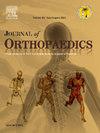用于膝外翻畸形初次全膝关节置换术的十字韧带固定假体的性能:系统综述
IF 1.5
Q3 ORTHOPEDICS
引用次数: 0
摘要
背景膝关节外翻畸形占初级全膝关节置换术(TKA)患者畸形的 15% 以上。1,2 膝关节外翻畸形最常用的两种假体是后稳定(PS)假体和十字韧带固定(CR)假体。与 PS 假体相比,CR 假体可保留 PCL 以获得本体感觉,且骨质切除较少,因此可提供更具优势的结构。本系统综述旨在汇总膝关节外翻畸形的初次 TKA 中使用的十字韧带固定假体的研究结果。方法根据 PRISMA 指南,在数据库中查询符合纳入标准的 CR TKA 研究。结果以胫股夹角衡量,术前和术后膝关节外翻畸形的差异有统计学意义(p < 0.001)。在我们的 710 例全膝关节置换术样本中,全因翻修率为 8.3%。结论这篇文献综述表明,尽管很少有报道,但在膝关节外翻畸形的初级全膝关节置换术中使用十字韧带固定假体可提供令人满意的结果,如活动弧度和膝关节评分。我们的研究结果表明,使用十字韧带假体治疗膝关节外翻畸形时,全因翻修率明显增加。因此,应进行进一步调查,评估这一特殊患者群体的失败模式。本文章由计算机程序翻译,如有差异,请以英文原文为准。
The performance of cruciate-retaining implants for primary total knee arthroplasty in valgus deformed knees: A systematic review
Background
Valgus deformity of the knee comprises upwards of 15 % of the deformities in primary total knee arthroplasty (TKA) patients. 1,2 The two implants most commonly used in valgus deformed knees are posterior stabilizing (PS) and cruciate-retaining (CR) implants. CR implants may offer a more advantageous construct due to the retention of the PCL for proprioception and less bony resection compared to PS implants. The purpose of this systematic review is to aggregate findings for cruciate-retaining implants used in primary TKA with valgus deformed knees.
Methods
In compliance with PRISMA guidelines, databases were queried for CR TKA studies which met the inclusion criteria. Cochrane ROBINS-I and the GRADE framework assessed bias and quality respectively.
Results
There was a statistically significant (p < 0.001) difference between preoperative and postoperative valgus deformity as measured by tibiofemoral angle. The all-cause revision rate was 8.3 % in our sample of 710 total knee arthroplasties.
Conclusion
This review of the literature demonstrates that, although scarcely reported, cruciate-retaining implants used in primary total knee arthroplasties in valgus deformed knees provide satisfactory outcomes such as arc of motion and knee score. Our results demonstrate a significant increase in all-cause revision when using CR implants for valgus deformed knee. For this reason, further investigations should be conducted to evaluate modes of failure in this specific patient population.
Level of evidence
IV systematic review.
求助全文
通过发布文献求助,成功后即可免费获取论文全文。
去求助
来源期刊

Journal of orthopaedics
ORTHOPEDICS-
CiteScore
3.50
自引率
6.70%
发文量
202
审稿时长
56 days
期刊介绍:
Journal of Orthopaedics aims to be a leading journal in orthopaedics and contribute towards the improvement of quality of orthopedic health care. The journal publishes original research work and review articles related to different aspects of orthopaedics including Arthroplasty, Arthroscopy, Sports Medicine, Trauma, Spine and Spinal deformities, Pediatric orthopaedics, limb reconstruction procedures, hand surgery, and orthopaedic oncology. It also publishes articles on continuing education, health-related information, case reports and letters to the editor. It is requested to note that the journal has an international readership and all submissions should be aimed at specifying something about the setting in which the work was conducted. Authors must also provide any specific reasons for the research and also provide an elaborate description of the results.
 求助内容:
求助内容: 应助结果提醒方式:
应助结果提醒方式:


